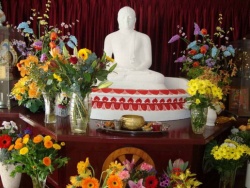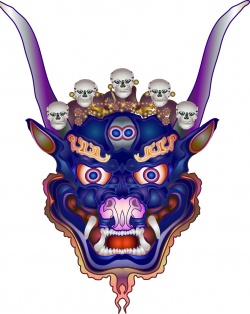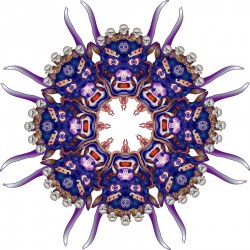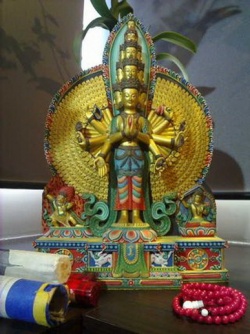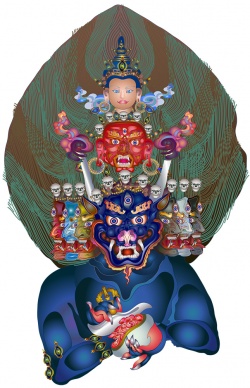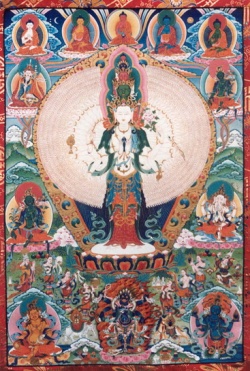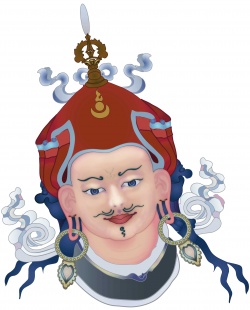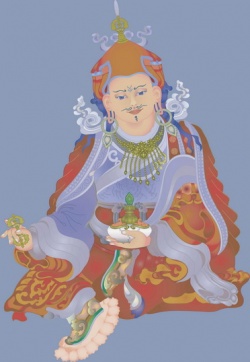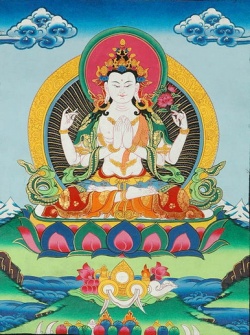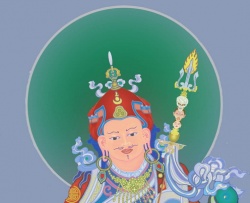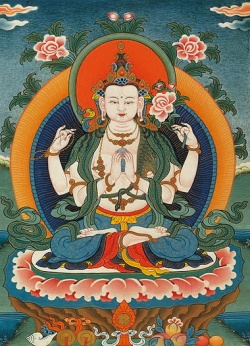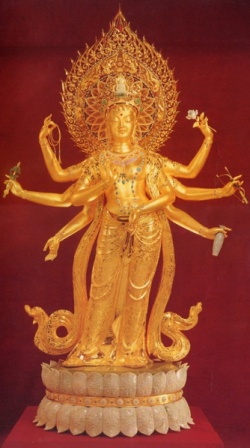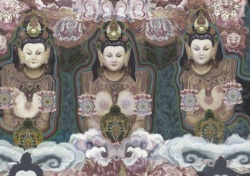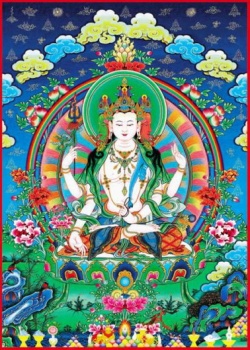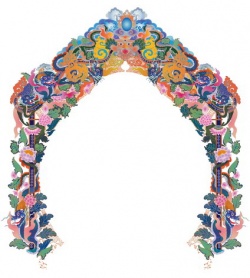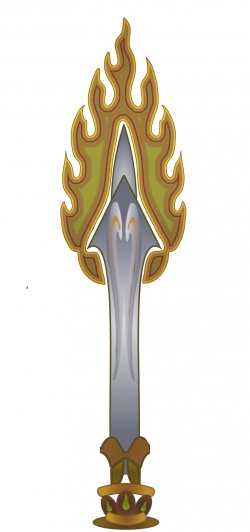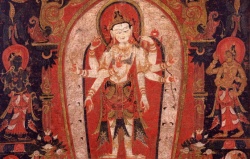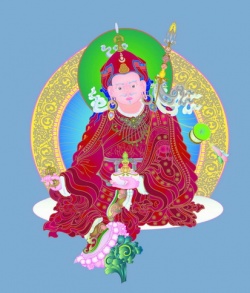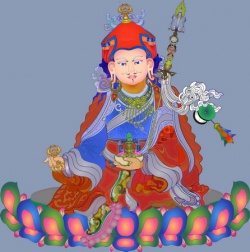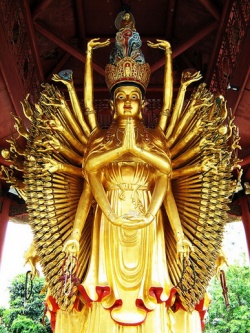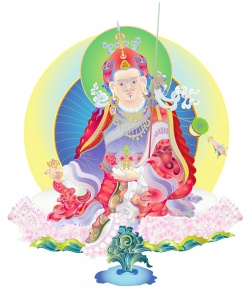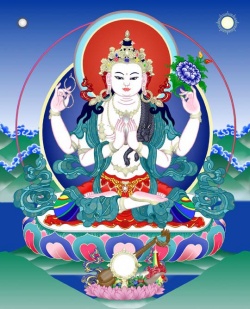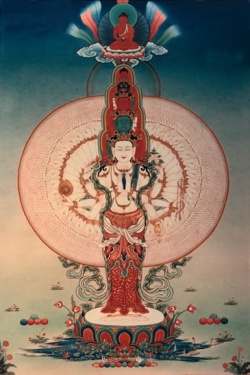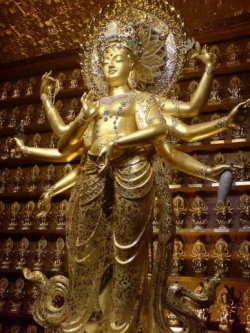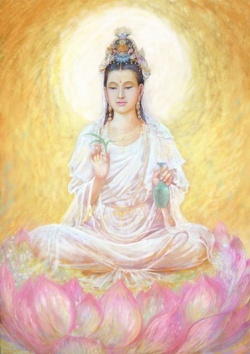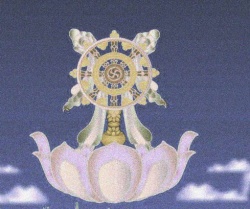Social responsibility, sex change, and salvation
Lucinda Joy Peach
Philosophy East and West
2002 v52 p50-74
1976 University Press of Hawai'i
Abstract:
Peach explores what the Lotus Sūtra teaches about social responsibility through the lens of gender by examining the specifically female-gendered images in the Lotus Sūtra in order to assess its messages regarding normative gender relations, and the implications of these messages for gender justice in the contemporary world.
Full Text:
Introduction
What does the Lotus Sūtra have to teach us about social responsibility? The immense influence and popularity of this Buddhist scripture throughout many parts of Asia (e.g., Watson 1993, p. ix) is reason enough to investigate its relation to social responsibility. In addition, the text of the Lotus Sūtra itself suggests a reason for examining its teachings on social responsibility by proclaiming itself to be the "one vehicle," the unifying law or truth, what Tamura Yoshiro describes as "the great unifying law of the universe that animates everyone and everything equally" (Tamura 1989, p. 41). More specifically, if we think of social responsibility in the contemporary world as encompassing "gender justice"-that is, fairness and equitable treatment for all persons, regardless of their gender-what is the Lotus Sūtra's message?
Does the Lotus Sūtra promote or deny gender justice, or is it simply indifferent on this issue? The continuing popularity and influence of the Lotus Sūtra throughout many parts of Asia, including China, Korea, and Japan, during a period in which traditional understandings of patriarchal and male-dominated social relations are being challenged as unjust, provides a motivation for examining the Lotus' relationship to gender justice. In particular, as Buddhism seeks "to justify itself as a religion suitable for modern Japan" (Tanabe 1989, p. 191), a nation currently struggling with changing gender roles and relationships between men and women, what role do or could the Lotus Sūtra's teachings about gender play in relation to gender justice?
Gender is an important category of analysis in the Lotus Sūtra. It provides a means for differentiating and hierarchalizing the status of males and females, both human and nonhuman. It symbolizes differences in temperament, capabilities, and virtues. Perhaps most importantly, it provides a basis for evaluating people's capacity for realizing the Mahāyāna ideal of full Buddhahood-anuttara-samyaksaṃbodhi-- as opposed to the "lesser" Hīnayāna Buddhist goal of arhatship. Before embarking on an analysis of the Lotus' teachings about gender, some qualifications are in order. First, although it has unquestionably had a significant influence in shaping attitudes about gender (e.g., Schuster 1985b, p. 91), [1] the specific influence of the Lotus Sūtra in shaping understandings of gender among its hearers and readers has varied significantly. The way its statements have been received, especially concerning normative gender roles, has undoubtedly been varied in different places and times, given the multivocal and multivalent character of Buddhist scriptures, as well as the diverse social locations of its hearers and readers.
Second, the influence of gender images does not necessarily correlate in any
direct way to the actual status of women in a particular social location (Sangren 1983, p. 4). For example, simply because negative images of females and views about women may abound in Buddhist texts widely disseminated in popular religious discourse does not necessarily mean that women will be subordinated in that society as a result. Conversely, positive textual images and valuations of females and the feminine do not necessitate that "real" women will be respected or esteemed. Indeed, the status of religious images of females and the feminine and the actual social status of women may even be negatively correlated. Thus, there is no one single or predictable way that gender images will influence those who encounter them.
In this article, I will examine the gendered imagery in the Lotus Sūtra in order to assess its messages regarding normative gender relations and the implications of these messages for gender justice in the contemporary world. The first part explores gender imagery in the Lotus Sūtra. The second compares these images with those found elsewhere in the Buddhist tradition in order to provide a clearer assessment of how representative the Lotus' messages are regarding gender in Buddhism more generally.
Gender Imagery in the Lotus Sūtra
General Observations
At the outset of this investigation, it should be noted that the Lotus Sūtra contains a wide variety of gender images, not all of them consistent with one another. One of the most significant messages of the Lotus as a whole is that because all persons possess Buddha-nature, and not only those of a certain birth, gender, aptitude, and so forth, the possibility of full Enlightenment is available to all beings (e.g., Watson 1993, p. xix; Niwano 1976, pp. 153, 159, 161-162). The specific passage providing perhaps the most egalitarian statement about gender relations in the text is the verse form of chapter 14, "Peaceful Practices." In an instruction to Mañjushrī concerning appropriate bodhisattva conduct, the Buddha advises that "one should not make distinctions by saying, `This is a man,' 'This is a man,' 'This is a woman."' This admonition is closely followed by the statement that "All phenomena are empty, without being, without any constant abiding, without arising or extinction" (Watson 1993, p. 200; see Hurvitz 1976, p. 14, and Katō et al. 1997, p. 225). The universality of this message (although contradicted elsewhere in the text!) suggests that women as well as men have the capacity to attain full, complete Enlightenment. In fact, Lotus translator Burton Watson claims that "the Lotus Sūtra reveals that its revolutionary doctrines operate in a realm transcending all petty distinctions of sex or species" (Watson 1993, p. xix).
Within the Lotus Sūtra's doctrine of the "two truths" of ultimate and conventional or relative reality, these passages describe the level of ultimate truth. Here, gender-as with all other distinctions-is irrelevant. At the level of conventional truth, however, gender distinctions are extremely relevant, as is obvious elsewhere in the Lotus. In contrast to the passage just cited, more often than not, the gender of
the beings populating the Lotus Sūtra is specified. For example, in stating who is present at an assembly to hear the Buddha's teachings, a frequent description begins "monks, nuns, laymen, laywomen ..." (e.g., Watson 1993, pp. 265-267). When they are described at all, the Buddha's disciples are usually referred to as "good men and good women" (ibid., pp. 239-240, 320). Gender is even used to make the argument of its own irrelevance, as when the rākshasa demon's daughters tell the Buddha they will protect the followers of the Lotus Sūtra against all manner of harm, regardless of the form it takes, "whether it be in man's form, in woman's form, in young boy's form, in young girl's form ..." (ibid., p. 310).
The salience of gender is also suggested in chapter 19, "Benefits of the Teacher of the Law," which states that the benefits to "good men or good women" of accepting and upholding this Lotus Sūtra include (in the verse form) knowing "the scent of living beings, the scent of men and women," including "wheel-turning kings of great authority, lesser wheel-turners and their sons," and "jeweled ladies of wheel-turning kings" (Watson 1993, p. 256). Gender is so important that the benefits of the heightened sense of smell include the ability to ascertain not only whether a pregnant woman's child "will lack normal faculties or be inhuman," but also whether it is "male or female" (ibid., p. 257)!
Gender is often a significant characteristic of beings of the nonhuman realms as well, indicating that beings are gendered throughout the universe, regardless of which realm they inhabit (Watson 1993, pp. 4, 249, 270). Chapter 19 describes those who are moved by hearing the Lotus as including
men and women of heaven, Shakra, Brahma and the other heavenly beings: Dragons and dragon daughters, yakshas and yaksha daughters, gandharvas and gandharva daughters, asuras and asura daughters, [2] garudas and garuda daughters, kimnaras and kimnara daughters, mahoragas and mahoraga daughters," as well as "monks, nuns, laymen, laywomen" and others. (Watson 1993, p. 260)
(Curiously, no explanation is given as to why the "sons" of these nonhuman beings are not also present!3) Similarly, chapter 26, "Dharani," relates that at the time of Heavenly King Upholder of the Nation there were ten daughters of rākshasa demons who, along with "the Mother of Devil Children," came to tell the Buddha of their vow to protect those who accept and uphold the Lotus Sūtra (Watson 1993, pp.309-310).
Gender is also specified with reference to the realms "above" the human. Chapter 19 refers to "heavenly women," who can be detected when "they whirl and circle in enjoyment," "adorned with lovely flowers and perfumes" (Watson 1993, p. 258), and chapter 27 predicts that those who copy the Lotus Sūtra will be reborn in the Trayastrimsha heaven, where "eighty-four thousand heavenly women, performing all kinds of music, will come to greet them" and "ladies in waiting" will be available to amuse them. Those who also understand and practice the Surra will be reborn in the Tushita heaven where the bodhisattva Maitreya has "hundreds, thousands, ten thousands, millions of heavenly women attendants" (ibid., p. 322).
In contrast to the presence of women in these heavenly realms, chapter 8, "Prophecy of Enlightenment for Five Hundred Disciples," describes the lands of the future Buddha; "Law Bright Thus Come One" is described as having "no evil paths of existence there, nor ... any women" (Watson 1993, p. 145). This is one of a number of places in the Lotus where females are depicted as inferior, either explicitly or implicitly. The linking of women with "evil paths of existence" indicates that the two are integrally connected, and that the presence of one leads to the presence of the other. Similarly, chapter 23, "Former Affairs of the Bodhisattva Medicine King," portrays Buddha Sun Moon Pure Bright Virtue Thus Come One's land as having "no women, hell dwellers, hungry spirits, beasts or asuras, and no kinds of tribulation" (ibid., p. 281). The implications of this verse are that women are incapable of attaining the realization that would result in their inhabiting this Buddhaland and that they are akin to hell dwellers, and so forth.
Similarly, in chapter 8, the Buddha's prophecy regarding Pūrna Maitrayaniputra is that his Buddha worlds will be beautiful and purified: "There will be no evil paths of existence there, nor will there be any women" (Watson 1993, p. 145). This is followed by the prophecy that "All living beings will be born through transformation and will be without lewd desires" (ibid.). Similarly, even women who follow the Lotus' teachings will be reborn in Amitayus' Buddha-land as males (ibid., p. 287), as will be discussed further later. Linking the absence of women to the absence of sex (both procreative and carnal) suggests that women are the cause of the problems resulting from sexuality. More specifically it indicates that human reproduction itself, which is here associated with women by proximity, is impure-perhaps because it is the immediate cause of rebirth into saṃsāric existence. Thus, the text's prescription for removing the problems of sexual desire and reproduction is to remove the women!
The absence of women from these Buddha-lands must be contrasted with the presence of women in the heavenly realms noted above. Although the "heavenly realms" are not nearly as advanced within the Lotus' cosmology as Buddha-worlds, they are nonetheless "higher" than the human realm. The presence of women in the heavenly realms may suggest that gender is not an obstacle to rising above the human realm, even if it may be a deterrent to attaining full Buddhahood. On the other hand, it may suggest that women are appropriately cast in heavenly realms only as sexual objects and pleasant playthings for men, not as a result of their own positive karma.
We thus find that the Lotus Sūtra reflects a certain polyvocality of gender messages regarding women. Some of the specific images of females in the Lotus Sūtra are inconsistent with one another, even directly opposed. Females are portrayed as both laity and monastics, bodhisattvas and shrāvakas, human and nonhuman, wealthy and poor, beautiful and ugly, devotees and non-Buddhists, diligent practitioners and lazy slackers, virtuous and virtueless. They are also relatively invisible throughout most of the text.
Almost all of the significant individuals in the text are men, including all of the
Buddhas, bodhisattvas, monarchs, and so forth. This makes the rare appearance of a woman-or even a female nonhuman being-notable by comparison. On several occasions, the Buddha refers to the gathered bodhisattvas and mahasattvas as "good men" (e.g., Watson 1993, pp. 212, 219, 224), as "my sons" or "these sons" (e.g., ibid., p. 220), as "the countless sons of the Buddha" (e.g., ibid., p. 235), or simply as " a son of the Buddha" (ibid., p. 244). Chapter 3, "Simile and Parable," describes bodhisattvas as "great men" (ibid., p. 53) and the Buddha as "the father of all living beings" (ibid., p. 61). This description is repeated in chapter 14, where aspiring bodhisattvas are admonished to think of the Buddhas as "kindly fathers" and "unsurpassed fathers" (ibid., pp. 204, 205). In the verse portion of chapter 7, "The Parable of the Phantom City," the Buddha describes himself as "the Dharma King" (ibid., p. 72).
Such male-gendered and patriarchal language indicates either that all of those present before the Buddha are male or that any females who might be present are not significant enough for the Buddha to speak to directly. Such language also contributes to a presumption that the important participants in the Buddha's life are male. This presumption is sometimes rebutted, however. In the introductory chapter, several of the women closest to Shākyamuni Buddha are specifically mentioned as being present. Among several categories of beings, women are mentioned in the category of "two thousand persons, some of whom were still learning and some who had completed their learning" (Watson 1993, p. 4). They include Shākyamuni's aunt and stepmother Mahāprajāpati and her six thousand followers, and Yasodhara, the wife whom Shākyamuni abandoned (along with their son Rāhula) when he left home to seek enlightenment. Both of these women have become Buddhist nuns, and are accompanied by their followers (ibid., p. 4). Thus, the presence of women at the very beginning of the Lotus Sūtra does convey the centrality of women as faithful followers of the Buddha. However, their placement after the arhats and before the bodhisattvas and mahasattvas (ibid., p. 4) suggests that they are in neither category, but instead have some other status.
Indeed, sometimes a gender hierarchy that makes males superior to females (although relatively, and not absolutely) is explicit. For example, in chapter 20, "The Bodhisattva Never Disparaging," included in the assembly are "Bhadrapala and his group, five hundred bodhisattvas; Lion Moon and her group, five hundred nuns; and Thinking of Buddha and his group, five hundred laymen" (Watson 1993, p. 269). Were males absolutely privileged, they would presumably occupy all of the exclusively spiritual roles. Yet here females occupy an intermediate position between bodhisattvas and laypersons. This intermediate location signifies that although women are not at the apex of the spiritual hierarchy, neither are they at the bottom.
In other parts of the Lotus Sūtra, women are the locus of non-virtue, as in chapter 14, "Peaceful Practices." Here, just before the verse quoted earlier regarding the irrelevance of gender distinctions, as the Buddha is instructing Mañjushrī regarding the four rules that bodhisattvas and mahasattvas should follow in preaching the Lotus Sūtra in the evil age, he advises that when preaching the law to women, each of them should not do so in a manner
that could arouse thoughts of desire in them, nor should he delight in seeing them. If he enters the house of another person, he should not engage in talk with the young girls, unmarried women or widows. Nor should he go near the five types of unmanly men or have any close dealings with them .... If he should preach the Law for a woman, he should not bare his teeth in laughter or let his chest become exposed. (Watson 1993, pp. 197-198)
In the event that the purpose of this instruction is not obvious, it is clarified by the following statement that "he should not have any intimate dealings with her even for the sake of the Law, much less for any other purpose" (Watson 1993, pp. 197-198).
In part, these admonitions seem designed simply-to use American legal terminology-to "avoid the appearance of impropriety" by removing bodhisattvas from sources of sexual temptation. The inclusion of "unmanly men" among the persons to avoid indicates that the problem is sex, not women. Nonetheless, the dominant references are to women, suggesting that it is the female sex that is problematic, not the males who risk experiencing sexual temptation. Such references thereby have the effect of symbolically linking women with sex, and thus with desire, and thus with attachment to saṃsāra theme repeated in many other Buddhist texts. Consequently, the association of women with sexual temptation indicates that women are more closely linked to saṃsāra than men are. Overall, then, the specific gender images in the Lotus Sūtra convey a somewhat inconsistent portrayal of women: they are apparently capable of full Enlightenment, but are more closely tied to saṃsāra than are men; they are present at the Buddha's teachings initially, yet are often absent, invisible, or ignored later. They are worthy of being instructed in the dharma by bodhisattvas, but are at the same time dangerous sources of sexual temptation. This ambivalence or multivalent message about gender is also found in the Lotus Sūtra's representations of gender in relation to Enlightenment.
Gender and Enlightenment
There are two main narratives in the Lotus Sūtra that address women's capacity for full, complete Enlightenment, located in chapters 12 and 13, approximately the middle of the text. The famous story of the Nāga King's daughter in chapter 12, "Devadatta," includes the most striking discourse in the entire text concerning women's capacity for Enlightenment. Mañjushrī describes the remarkable talents and wisdom of the eight-year-old daughter of the dragon king Sagara as follows:
She has mastered the dharanis, has been able to "accept and embrace all the storehouse of profound secrets preached by the Buddhas, has entered deep into meditationy grasped the doctrines, and in the space of an instant conceived the desire for bodhi and reached the level of no regression." (Watson 1993, p. 187)
Her final talent is that she is "capable of attaining bodhi" (ibid.).
Bodhisattva Wisdom Accumulated doubts the dragon girl's talents, skeptically saying "I cannot believe that this girl in the space of an instant could actually achieve correct Enlightenment." But even before he finishes speaking, the scripture relates that "the dragon king's daughter suddenly appeared before the Buddha" and
recites verses of praise for him. She herself proclaims that having heard his teachings, she has attained bodhi, which "the Buddha alone can bear witness to" (Watson 1993, p. 188). Now Shāriputra becomes the doubtful one, arguing that it is difficult to believe that she has been able to attain so much in such a short time "Because a woman's body is soiled and defiled, not a vessel for the Law," because the path takes "immeasurable kalpas" in order to achieve success, and because "a woman is subject to the five obstacles," which means she cannot become a Buddha (or a universal monarch, a Sakra-god, Brahma, or a Māra). Shāriputra's doubts are concluded with the question "How then could a woman like you be able to attain Buddhahood so quickly?" (ibid., p. 188).
The dragon girl's response to Bodhisattva Wisdom Accumulated and Shāriputra is to demonstrate how rapidly she can attain Enlightenment. By comparing the speed with which she hands the Buddha a precious jewel (and he accepts it), she instructs the assembled to "Employ your supernatural powers and watch me attain Buddhahood. It will be even quicker than that!" (Watson 1993, p. 188). She then changes into a man "in the space of an instant," carries out all the practices of a bodhisattva, attains "impartial and correct Enlightenment," and expounds "the wonderful Law for all beings everywhere in the ten directions" (ibid., p. 188). In response, thousands of the assembled progress along the path to Enlightenment, and "silently believed and accepted" the dragon girl's feats.
In portraying Enlightenment as an almost instantaneous process rather than a gradual one taking innumerable lifetimes, the dragon-girl narrative differs from many other stories in the Lotus Sūtra. In fact, Nancy Schuster argues that it "clearly and boldly" states that
the old notion that a woman's body disqualifies her from Buddhahood is wrong, for here is a Buddha-to-be (the Dragon-princess) who was born female .... Bodhisattva-hood is not inconsistent with having a female body; in fact, one can be reborn as a woman, as the Dragon-princess was, after having progressed very far on the path to Buddhahood .... (Schuster 1981, p. 43)
She contends that the Lotus Sūtra's argument "is directed against the notion that some bodies (male) are fit for the highest destinies, and other bodies (female) are not.. It is the understanding of the disciples that is at fault; those who understand the Lotus' teaching-like Mañjushrī-see no problem in the sex or the age of the girl-Bodhisattva" (Schuster 1981, p. 45).
Although Schuster is correct that this narrative disrupts conventional understandings that high levels of spiritual understanding and attainment are not possessed by females, Schuster's argument overlooks the necessity of a physical change from male to female before these females can attain complete Enlightenment. The narrative in the Lotus Sūtra thus affirms the very view that Schuster claims it undermines, that is, that it is necessary to have a male body in order to become a Buddha. If Schuster was correct that this and analogous sūtras established that "physical differences between male and female are irrelevant to the attainment of Enlightenment" or that "the distinction of male and female is essentially a matter of incomplete
misunderstanding" (Schuster 1981, p. 44), then there would be no need for the females in these narratives to transform themselves into males!
In supporting her view that these gender-transformation stories collectively reflect a positive view of women as spiritually and intellectually equal, Schuster points out that the view we heard Shāriputra voice in the dragon-girl narrative-that women are subject to the "five obstacles" or disqualifications-was a widespread belief in Mahāyāna Buddhism. Given this "problem" with the female body from the standpoint of Buddhist doctrines that make male bodily characteristics critical "marks" of spiritual attainment in the conventional world, Schuster and others argue that the gender-transformation narratives provide an effective way of resolving the difficulty while not precluding the possibility of females attaining complete Buddhahood in this very life (Schuster 1981, p. 29; Kajiyama 1982, p. 66).
Similarly, Nikkyo Niwano argues:
Women of today may feel dissatisfied that the dragon's daughter was suddenly transformed into a male and then became a buddha. Such an expression was used merely because of the idea of women in ancient India. The sudden transformation of a woman into a male means nothing but the transcendence of the difference between male and female .... Observed with the Buddha's eyes, all living beings are equal. We must never misinterpret this. (Niwano 1976, p. 159)
Along the same lines, Diana Paul explains the gender transformations as necessary, given the historical cultural context in which a woman's family responsibilities to marry and become the mother of sons would restrict her religious roles (Paul 1985, p. 193).
Nonetheless, the dragon girl's gender transformation has dubious value for contradicting Shāriputra's assessment of the spiritual limitations of women. On the one hand, the Nāga King's daughter demonstrates that there is nothing inherent about gender that prevents a woman from attaining Enlightenment by becoming a man. On the other hand, her gender transformation into a male reinforces the belief that it is in fact necessary for females to take on a male form in order to become Enlightened. The gender shift, although signifying the insubstantiality and ephemerality of sex, also reinforces the image that women are incapable of attaining Enlightenment in female form. The sex change thus perpetuates a male-biased view that only men can achieve complete Buddhahood, and thereby limits the force of the Lotus Sūtra for promoting gender justice.
In contrast to the dragon-girl story in chapter 12, the "prediction" narrative of chapter 13 is the most affirmative statement of women's capacity for full Buddhahood in the entire Lotus Sūtra. In this chapter, "Encouraging Devotion," the Buddha's stepmother Mahāprajāpati and his former wife Yasodharā, along with their entourages of followers, are gathered among an assembly where hundreds and thousands are being given prophecies of future Enlightenment. The nuns are described as either "some still learning" or "others with nothing more to learn" (Watson 1993, p. 191), indicating that women are capable of high levels of spiritual achievement.
The Buddha asks Mahāprajāpati why the nuns are all looking at him in a perplexed manner, suggesting that perhaps it is because their names are not among those prophesied to attain Enlightenment. He then reminds her that he earlier made a general statement "saying that all the voice-hearers had received such a prophecy," implying that she has nothing to worry about. Then, seemingly to appease her insecurities, he continues by saying:
in ages to come, amid the Law of sixty-eight thousands of millions of Buddhas, you will be a great teacher of the Law, and the six thousand nuns ... will accompany you .... In this manner you will bit by bit fulfill the way of the bodhisattva until you are able to become a Buddha with the name Gladly Seen by All Living Beings Thus Come One. (Watson 1993, p. 191)
He then tells her that this Buddha will prophecy the future Enlightenment of the six thousand bodhisattvas.
Next, Yasodharā thinks to herself she has been left out of the Buddha's prophecy, and the Buddha tells her that in future ages she, too, will become a bodhisattva, a great teacher of the Law, and will gradually fulfill the Buddha-way, becoming Buddha Endowed with a Thousand Ten Thousand Glowing Marks Thus Come One. Mahāprajāpati, Yasodharā, and all the nuns together tell the Buddha that having heard the prophecies, their minds are peaceful and tranquil, and that they will be able to go to other lands to propagate the Sūtra (Watson 1993, p. 192). Even though it will take "ages" to occur, these predictions are not accompanied by the qualification that women need to change their female bodies first, as is the dragon girl's narrative. Although these women are depicted as somewhat jealous and lacking in patience and faith, they are all deemed to be capable, worthy, and ultimately successful in attaining full, complete Enlightenment.
These two narratives present an interesting juxtaposition. In the dragon-girl story, the Enlightenment of the female is seemingly instantaneous, yet requires her to undergo a sex-change operation. In the latter, Enlightenment is predicted for women without any such prerequisite, yet it will take "ages to come." Despite the ambiguities and ambivalances, both narratives affirm women's capacity for Enlightenment. They both thus generally support the principle of gender justice, albeit in a qualified way.
In addition to these two dominant narratives, other passages relate women's capacity for spiritual achievement, if not full, complete Enlightenment. For instance, in chapter 27, "Former Affairs of King Wonderful Adornment," after describing how two sons succeed in gaining their mother's permission to become renunciants, the text relates that "At that time the eighty-four thousand persons in the women's quarters of King Wonderful Adornment were all capable of accepting and upholding the Lotus Sūtra" and the "king's consort had gained the samadhi of the Buddhas' assembly and was capable of understanding the secret storehouse of the Buddhas" (Watson 1993, p. 315).
But chapter 23 reinforces the message that only males can attain Enlightenment in proclaiming that "If there is a woman who hears this chapter on the Former Affairs of the Bodhisattva Medicine King and is able to accept and uphold it, that will be her
last appearance in a woman's body and she will never be born in that form again" (Watson 1993, p. 287). This prediction continues:
If in the last five hundred year period after the Thus Come One has entered extinction there is a woman who hears this sūtra and carries out its practices as the sūtra directs, when her life here on earth comes to an end she will immediately go to the world of Peace and Delight where the Buddha Amitayus dwells surrounded by the assembly of great bodhisattvas and there will be born seated on a jeweled seat in the center of a Lotus blossom. He will no longer know the torments of greed, desire, anger, rage, stupidity or ignorance .... (Watson 1993, p. 287)
The Buddha will join in praising this now-male woman with "Excellent, excellent, good man!" and the prediction that "there will be none among the voice-hearers, pratyekabuddhas, or bodhisattvas whose wisdom and ability in meditation can equal yours!" (Watson 1993, p. 288). This prediction reinforces the view of women as inferior to men, and serves to undermine the more positive gender messages in chapters 12 and 13.
As we can see, the gender imagery in the Lotus Sūtra fails to provide any certain and clearly articulated teaching regarding women's status or capacity for Enlightenment. Although the Lotus states that gender distinctions are irrelevant, the gendering of most beings who appear in this sūtra and the frequent evaluation of their spiritual capabilities on the basis of gender suggest that gender differences are significant, and that they are significant precisely for the purpose of hierarchalizing men as superior to women.
This negative assessment of the implications of the Lotus Sūtra's teachings for gender justice is reinforced by a comparison with the gender imagery and narratives of gender transformation in other Buddhist texts.
Comparisons with Other Buddhist Scriptures
Many other Buddhist scriptures contain gender imagery that might be used as a basis of comparison with the Lotus Sūtra)]. The entire range of images we see in the Lotus appear in some other scriptures, although perhaps there is no single scripture containing as wide a diversity of gender images. In general terms, earlier scriptures and Theravādan texts tend to contain more negative female images, especially of the "woman as sexual temptress" variety, while Mahāyāna texts reflect a broader array of feminine images, ranging from the most misogynistic to the most elevated spiritual doctrines.
Scholars have suggested that the negative images of women in many early Buddhist texts, especially as sexual temptresses, indicate that monks considered women's sexuality as a threat, not only to their pursuit of the spiritual path but also to the stability of the monastic order as a whole, and even to the cycles of birth and death within saṃsāric existence as a whole (Sponberg 1992, p. 20; Lang 1986, p. 64; Paul 1985, p. 303; Falk 1974, p. 108).
For example, in the Udayanaatsarajaprarivartah Sūtra, part of the Ratnakuta collection of sūtras, the Buddha tells King Udayana that "when men have close relationships with women, they have close relationships with evil ways" (Paul 1985, . 30). The verse form continues:
Fools
Lust for women
Like dogs in heat.
They do not know abstinence.
They are also like flies
Who see vomited food.
Like a herd of hogs,
They greedily seek manure.
Women can ruin
The precepts of purity.
They can also ignore
Honor and virtue
Causing one to go to hell.
They prevent rebirth in heaven.
Why should the wise
Delight in them?
...
Women can compound one's suffering,
By their perfume
One falls in love.
The fool,
Confused, yearns for her.
Being close and admiring
Insignificant things,
He turns away from wisdom.
(Paul 1985, pp. 31-32)
The use of the female body as a symbol of attachment to the world of sensuality is a common theme throughout the Buddhist world, beginning with the story of the Buddha's renunciation from lay life. Siddhārtha Gautama abandons not only his young wife and newborn son but also a household of beautiful female musicians and dancing girls that his father had provided for his entertainment. The Buddha's struggle for Enlightenment under the bodhi tree years later involves rejecting the sensual enticements of Māra's "daughters," who have been sent to seduce him away from his spiritual goal.
Even within the earliest stratum of Buddhist texts, however, positive images of women exist. For example, the Therīgāthā, "Songs of the Sisters," is a collection of the poems and narratives attributed to the first women Buddhist nuns (see Rhys Davids and Norman 1989; Murcott 1991). Many of these poems describe the female subjects and their Enlightenment experiences very positively. Alan Sponberg sug-
gests that "the most important point regarding the place of women in early Buddhism" is that "women could and did become arhats, fully liberated individuals" (Sponberg 1992, p. 6). Nonetheless, he tells us that by the first century C.E., a vehement debate had emerged regarding whether a woman could become a Buddha (ibid., p. 24). Evidence of that debate is apparent in the negative images of women and the emergence of the "five obstacles" included in the Lotus and a number of other Buddhist scriptures. For instance, the Cullavagga (chapter 10) includes "the eight special rules"! disciplinary rules only applicable to female renunciants that were designed to insure their subordination to the monks (see Sponberg 1992, pp. 14-15; Lang 1986, p. 65; Murcott 1991).
Although, as we have seen, the Lotus Sūtra contains some references to women as seductive "snares," these are not the dominant images. In addition, the Lotus does not emphasize the need to subjugate women to men in either monastic or lay life as early texts do. (Of course, the silence on this issue may simply reflect its institutionalization to the extent that it was no longer considered something that needed to be remarked upon.)
Later Mahāyāna texts contain both negative and positive images of women. Diana Paul classifies Mahāyāna literature depicting women's role as bodhisattvas into three categories:
(1) texts in which women are denied entrance to a Buddhaland;
(2) those in which women are accepted as lower-stage bodhisattvas; and
(3) those in which women are accepted as advanced bodhisattvas and imminent Buddhas (Paul 1985, p. 169). Of the first type, the Bodhisattvabhumi argues that women are inherently weak in intellect and virtue, traits which would certainly limit their capacity for Buddhahood (Schuster 1 985b, p. 102). In the Pure Land Sūtra, a bodhisattva suggests that after his Enlightenment, women who hear his name should despise their female nature and not be reborn as females (Paul 1985, p. 170). Elements of this doctrine are also apparent in the Lotus, as we have seen.
According to Paul, sūtras containing the second type are the most common. Women are depicted as having some spiritual capacity, but their authority remains secondary to men's. The device of gender transformation provides a means for extraordinary females to be recognized for their superior virtues and merits by changing their sex to become bodhisattvas or even Buddhas within this life (Paul 1985, pp. 170-171). 1 will further examine sūtras in this second category shortly.
In the third category, gender is not an obstacle to complete Buddhahood or Enlightenment. Sponberg suggests that some factions of the Mahāyāna-specifically Vajrayana Buddhism-revived an earlier ideal of gender inclusiveness by positing "soteriological androgyny" in the sixth or seventh century C.E. The underlying assumption of this doctrine is that all beings possess the full range of both male and female characteristics. Sponberg claims that the earliest antecedents of this development are in the early Mahāyāna, in the Prajñāpāramitā (Perfection of Wisdom) sūtras, in which the perfection of wisdom is portrayed as female, "the mother of all the Buddhas" (Sponberg 1992, pp. 24-25).
The popularity and frequency of "Enlightened female" images varies to some extent among Buddhist cultures, but is readily available throughout Mahāyāna Buddhism. For example, the male bodhisattva Avalokiteshvara in India underwent a gender transformation to become the female bodhisattva Kuan Yin in China. Kuan Yin is tremendously popular in Taiwan, where almost every community has at least one temple devoted to her worship (Sangren 1983, pp. 6-7). Similarly, Tibetan Vajrayana texts contain a multitude of female images, many of them quite positive. These include symbolic representations of the perfection of wisdom as the goddess Tārā, multitudes of dākinīs (a kind of female spirit) who render spiritual assistance to practitioners, and a number of female bodhisattvas and female "consorts" or partners of male Buddhas (Campbell 1996; Gross 1993; Klein 1995; Shaw 1994; Havnevik 1989).
Nonetheless, even in Mahāyāna Buddhist texts written a millennium after the time of the Buddha, there remain quite negative images of women, such as the "horrific figurations of the feminine" that Liz Wilson describes: "grotesque" portrayals of disfigured and decaying females who are characterized as vile, foul, disease-ridden, the cause of suffering and death (Wilson 1996). Such images are quite similar to those in popular Theravada Buddhist texts, such as the Thai funeral sermon "Blessings of Disposing of Corpses," in which the images of a beautiful young woman are contrasted with those of her rotting corpse in order to convey the principle of impermanence (Keyes 1984, p. 231).
Paul's comparative analysis of gendered imagery in Buddhist texts concludes that the sūtras containing the most positive images of women and the female or feminine are by far the smallest percentage. In addition, these positive female images-like the bodhisattva Kuan Yin, who has a maternal role but is beyond sensuality, and the Buddha Amitabha, who embodies a combination of masculine and feminine qualities-still tend to associate women with passion and with physical and mental weakness (Paul 1985, pp. 307-308). Even further (a point that Paul fails to note), the portrayal of females as "advanced bodhisattvas" and "imminent Buddhas" is not synonymous with a portrayal of women as Buddhas, and thus does not signify that being female is not an obstacle to full Enlightenment.
Since a number of Buddhist texts in Paul's second category include variants of the Lotus' two dominant gender narratives (the entry of the Buddha's female kin Mahāprajāpati and Yasodharā into the monastic order, and the gender transformation of the Nāga King's daughter), these provide a useful basis for assessing how the Lotus Sūtra's portrayal of gender status and hierarchy compares to other parts of the Buddhist literary corpus. First, it is interesting to note that the Lotus Sūtra excludes certain negative aspects of the original renditions of the narrative in the Pali Canon relating to the entry of the Buddha's female relatives into the Sangha. In the Cullavagga, the Buddha turns down Prajapati's request for admission to the Order on behalf of herself and her five hundred women followers on three separate occasions, and only relents because his trusted servant Ananda intercedes on the women's behalf. And even then, although conceding that women are not lacking in capacity to pursue the spiritual path, the Buddha proclaims that the entry of women into the Order will result in Buddhism lasting only five hundred years, rather than the one
thousand years it otherwise would have endured (Cullavagga, chap. 10.1.1-6, quoted in Murcott 1991, pp. 13-19; Rhys Davids and Norman 1989, pp. 71-73). [4]
The absence of these aspects of the original narratives from the Lotus suggests that they are irrelevant to its main purposes. As discussed earlier, the Buddha's female relatives are presented in the Lotus in the context of the Buddha's predicting the future Enlightenment of his followers. Thus, rather than highlighting the difficulties that women present to Buddhism, the Lotus' emphasis is on their capacity for full, complete Enlightenment (even if not in female bodies). This portrayal of women is consistent with the principles of gender justice.
Second, gender-transformation narratives similar to those in the Lotus appear in several Mahāyāna sūtras, especially in the Mahārākuta, a collection of forty-nine sūtras. A brief description of these sūtras reveals some interesting similarities with and differences from the Lotus Sūtra. Some of these sūtras follow the same gender transformation sequence that is evident in the Lotus. For example, the Sumati Sūtra also involves an eight-year-old female-here the daughter of a householder in Rājagriha-addressing the Buddha and his gathered assembly. Sumati asks the Buddha a series of questions. Conforming to gender-role stereotypes, her first questions concern appearance and wealth: "For what reason does one become beautiful? What causes someone to have great wealth, or an undivided retinue?" (Nattier 1994, p.1).
Then, as in the narrative of the Nāga King's daughter in the Lotus Sūtra, one of the Buddha's closest disciples-here, Mahāmaudgalyāyana, Shāriputra's counterpart-expresses skepticism regarding the girl's ability to fulfill the difficult teachings that the Buddha has just given. Sumati then performs two "acts of truth" that convince Mahāmaudgalyāyana of Sumati's capacities as a bodhisattva. In the first, she avers that if her future Buddhahood is true, and her buddha-field "will be free from the faults of womankind," that the assembly may turn golden in color-which it immediately does (Nattier 1994, p. 5)!
The bodhisattva Mañjushrī challenges Sumati's understanding in a series of questions, which she answers to his satisfaction. He then asks her why she hasn't changed out of her female body. She tells him that the statements "'This is a woman, this is a man' are the [result of] objectivizing. You should become free of doubts about this" (Nattier 1994, p. 7). Nonetheless, in a second act of truth, she says that "If it is true that I shall attain Tathagatahood ... may I now ... change into a man," and then does (Schuster 1981, pp. 30-31). "He" resolves that in his future Buddhaland, there will be no influence of Mira, no hells, and no "'women's demeanor"' and proclaims that " If I shall accomplish this, let my body be like that to a 30-yearold monk.' This too, occurs" (ibid., p. 31). The negative appraisal of women, coupled with Sumati's change of sex, makes this sūtra's gender portrayal very similar to that of the Lotus Sūtra.
In the Pure Gift Sūtra, the twelve-year-old daughter of King Prasenajit, called Pure Gift, with a company of five hundred women and five hundred Brahmanas, encounters the Buddha accompanied by eight disciples and eight bodhisattvas. One
by one, she questions them about the dharma in ways that make them aware of the flaws in their own understandings, and leaves them speechless. To the bodhisattva Nondeluded Views, for example, she points out that the Buddha cannot be seen at all because his truth is formless, so those who see his material body do not see the Buddha. (This might be interpreted as a criticism of those who make distinctions based on bodily characteristics, such as sex.)
Pure Gift then asks the Buddha eighteen questions about the bodhisattva path. Among them are questions concerning how to obtain a transformation rebirth (question 8) and the thirty-two marks of a mahāpuruṣa ("great man") (question 13). Mahāmaudgalyāyana accuses her of not taking the bodhisattva career seriously or understanding it, since she cannot attain perfect Enlightenment in a woman's body. In response, Pure Gift makes an Act of Truth that if her words are true, a series of miracles will occur, including that her female form will change into that of a boy. These happen as she predicts, Mahāmaudgalyāyana is convinced, and the Buddha predicts her attainment of perfect Buddhahood.
Despite this evidence of her worthiness, Mahāmaudgalyāyana again challenges Pure Gift, asking her why, if she is so advanced in understanding, she hadn't changed her female body before this. She answers with a question of her own, asking him why, since he has been praised by the Buddha as best in the attainment of supernatural powers, he hadn't changed his male body! He is speechless, and she continues by telling him that "'Neither with a female body nor with a male body is true Enlightenment attained ... for there is no achieving perfect Enlightenment in any way"' (Schuster 1981, p. 35, citing T.12.338, pp. 96.c25-27). At the conclusion of the sūtra, both Mañjushrī and the Buddha praise Pure Gift and the Buddha completes the prophecy of her Buddhahood. The Pure Gift Sūtra also parallels the Lotus in both asserting the irrelevance of gender yet having the female bodhisattva change into a male form. Despite these parallels, however, both the Sumati and Pure Gift sūtras are more supportive of gender justice than the dragon girl's gender transformation in the Lotus because they include messages about the ultimate irrelevance of gender distinctions.
In Pure Faith's Question, King Prasenajit's young daughter Pure Faith goes with five hundred women companions to visit the Buddha in the Jeta grove at Sravasti, and questions him about bodhisattva practices. After the Buddha's twelve-part reply, which describes the requirements of the bodhisattva to understand the sameness of all beings, all dharmas, and all ways of understanding, Pure Faith asks him what a woman must do to change her female body. The Buddha's answer lists sixteen things (two groups of eight each):
avoid envy, stinginess, flattery, anger, be truthful, slander no one, abandon desire, and all wrong views, revere Buddha and Dharma, make offerings to monks and to Brahmanas, give up attachment to home and family, accept the preceptse no evil thoughts, become indifferent to her female body, abide in the thought of Enlightenment and the dharmas of the Great Man, regard worldly life as like an illusion, like a dream. (Schuster 1981, p. 37)
Pure Faith and her companions then scatter garlands and jewelry over the Buddha, and resolve to follow the bodhisattva path and to "abandon the corruptions of the female body." The Buddha predicts that at the end of their present lives, all of them will abandon their female bodies and be reborn in the Tushita Heaven to serve and make offerings to Maitreya and all the Tathāgatas of the present era. The Buddha predicts that after countless aeons, Pure Gift will become a Buddha with her own Buddha-land, and the five hundred women will be the leaders of her retinue. The sūtra ends with the promise that "if a woman hears this sūtra, accepts it and recites it, when her female body dies, she will never again be reborn a woman and will quickly attain to perfect Enlightenment" (Schuster 1981, p. 37).
Schuster interprets Pure Faith's second question as indicating that she has not yet learned the truth of the Buddha's answer to her first question; that had Pure Faith truly comprehended the necessity of seeing the sameness of all beings, she wouldn't be distinguishing between male and female bodies (Schuster 1981, p. 37). Unlike the pattern in other gender-transformation sūtras, here Pure Faith herself is asking how she can change her female body, rather than being pressured to do so by others. Nonetheless, the Buddha answers her question without hesitation or qualification. This, in combination with the conclusion of the sūtra, reinforces the necessity that women change their female body in order to attain complete Enlightenment. Under these circumstances, Pure Gift's second question to the Buddha does not seem at all to be the result of ignorance, but, instead, of awareness of the obstacles faced by a female striving to attain perfect Enlightenment. In these respects, the Pure Faith Sūtra expresses the same message as the Lotus.
Yet other gender-transformation narratives can be viewed as more egalitarian than the Lotus. For example, the Gangottara-sūtra in the Ratnak ūta Sūtra describes a dialogue between the Buddha and the lay disciple Gangottara in the )eta grove at Sravasti. Gangottara is instructed to regard all dharmas, including herself, as being like magical creations, empty like space that is without any impediments. After their dialogue, she and the rest of the assembly become monastics, and the gods who had been listening note that "This upasika is truly extraordinary, for she is able to converse fearlessly with the Tathagathas" (Schuster 1981, p. 39).
The story called "Jewel Brocade Receives the Prediction" in the Sūtra of Sagara, the Nāga King, a sūtra translated into Chinese in 285 C.E., bears marked similarities to-but also important differences from-the story of the Nāga King's daughter from the Lotus Sūtra. Here, Mahākāshyapa tells Sagara's daughter Jewel Brocade that "One cannot attain Buddhahood within a woman's body." She responds that if this is so, then it is also the case that one cannot attain Buddhahood within a man's body, since "the thought of Enlightenment is neither male nor female," "the one who perceives through Emptiness is neither male nor female," and "the one who perceives through Enlightenment has the Dharma which is neither male nor female" (Paul 1985, pp. 235-236). At the end of the narrative, the Buddha predicts Jewel Brocade's future Buddhahood. Unlike the Nāga girl's story in the Lotus Sūtra, Jewel Brocade does not change her sex in deference to male monastic questioning, but
rather refutes the entire mode of thinking that would make such a change necessary. Similarly, in the Shrīmālāsimhanada-sūtra, Queen Shrīmālā validates her spiritual attainments without being required to change her female form. As Schuster says, she is accepted as a true dharma teacher in her female body.
Finally, in the Vimalakīrtinirdesha, another early Mahāyāna sūtra, a goddess suddenly appears after listening to Vimalakīrti (a householder bodhisattva) tell Mañjushrī that all beings should be regarded as like creatures created by a magician or as a mirage. She sprinkles flowers on the assembly, and the petals roll off the bodhisattvas' bodies, but stick to those of the disciples, despite the latter's attempts to shake them off. The goddess asks Shāriputra why he wants to get rid of the flowers, and he says that they are not proper for disciples. She accuses him of being hung up on the false distinction between proper and improper, which is the very reason why the flowers are clinging to him while not troubling the bodhisattvas. Her explanation silences Shāriputra (Schuster 1981, pp. 41-42).
Shāriputra then asks the goddess why she has not changed her female form. She tells him that she has looked for femaleness during the twelve years she has lived in Vimalakīrti's house, but has not found it, "for what one calls a woman is something created by magic-and can one ask something created by magic to change its femaleness?" (Schuster 1981, p. 42). The goddess then exercises her powers to exchange bodies with Shāriputra, and she asks him "Why don't you change your female form?" He tells her he doesn't even know how he acquired a female body. She explains that it is so with all women: "Just as you are not really a woman but appear to be female in form, all women also only appear to be female in form but are not really women. Therefore, the Buddha said all are not really men or women" (Paul 1985, p. 230). The goddess then switches their bodies back to their original forms.
Shāriputra asks her where she will be reborn next, and she says it will be where the Buddha's transformations are reborn. He retorts that these are not reborn, which is, the goddess notes, true for all beings. Shāriputra asks her when she will attain complete Enlightenment, and she tells him that no one ever can, since Enlightenment has nothing to rest upon and so cannot be grasped (Schuster 1981, p. 42). At the conclusion of this narrative, Vimalak-rti informs Shāriputra that the goddess has already served many previous Buddhas and has attained the tolerance of the notion that dharmas do not arise. This gives her the resolve to attain a Buddhahood that "permits her to manifest wherever she wishes in order to teach and develop living beings" (ibid., p. 43).
These last two sūtras are more affirmative of women's spiritual capacities than many other gender-transformation narratives, including that in the Lotus. The Shrīmālāsimhanada and Vimalakīrtinirdesha sūtras in particular promote gender justice by indicating that women are capable of the highest spiritual achievement-Buddhahood-without having to change their female form. The Lotus Sūtra lacks a corollary. Nevertheless, even these more positive representations still do not portray women as Buddhas, and thus fail to evoke a full-bodied principle of gender equality.5
Interpretation and Analysis
Measuring the gender imagery in the Lotus Sūtra against that in comparable Buddhist texts reinforces the earlier assessment that this text reflects somewhat ambivalent and contradictory messages regarding women's capacity for Enlightenment. Whereas the prediction story in chapter 13 is more positive than other scriptural accounts of the Buddha's interactions with his female relations because it omits their sexist underpinnings, the gender-transformation narrative in chapter 12 is less affirmative of gender justice than counterparts in some other scriptures because it insists on the necessity that women change their sex in order to attain Enlightenment.
Compared with the spectrum of gender imagery in Buddhist literature, the Lotus Sūtra can be viewed as something of a microcosm: it includes representations of females as hindrances to the pursuit of Enlightenment by (male) monastics, as well as depictions of females themselves-as nuns, laywomen, bodhisattvas, and even nonhuman beings-as sincere and dedicated practitioners of the Dharma. By comparison with the range of images of women in other Buddhist texts, those in the Lotus fall along the more positive than negative end of the scale. Negative images are fairly infrequent.
By the same token, the Lotus Sūtra is not quite as egalitarian in its message as scriptures such as the Gangottara, the Nāga King, or the Sūtra of Sagara, where no gender transformation is necessary as a condition for women's Enlightenment. Nor is the Lotus as positive as texts such as the Vimalakīrtinirdesha, where proclamations of the irrelevance of gender are reinforced by playful gender-bending that changes males into females as well as the reverse. Even though the Lotus includes statements to the effect that gender is irrelevant to Enlightenment, the dominant narratives in this text suggest that gender is indeed relevant: that being a woman is an impediment that must be eliminated before Enlightenment can be achieved or else it will retard the achievement of this goal "for ages to come." By comparison with other Mahāyāna scriptures, then, the Lotus does not reflect the strongest possible message regarding gender equality and the irrelevance of gender distinctions.
Against such affirmative endorsements of the spiritual capacity of the female gender in other Buddhist texts, the dragon-girl narrative is not as glowing a portrayal of women's spiritual capacity as some have claimed. Schuster actually seems somewhat equivocal in her assessment of the Lotus Sūtra's positive message about the female's capacity for Enlightenment, however, since she admits that this narrative's treatment of gender transformation is "less satisfactory" than in other texts because a "change of sex does seem to be necessary ... if a woman is to take the final step to Buddhahood" (Schuster 1981, p. 44). She argues that in other gender-transformation narratives, by contrast, change of body is like a magician's transformations, and so is everything that ordinary persons take to be real in this world. Femaleness and the transformation into a male are not ultimately real, but both can be used by the bodhisattva to reach and instruct benighted sentient beings (Schuster 1981, p. 45).
Schuster claims that the main difference between the Lotus Sūtra and the other
gender-transformation narratives she discusses is that the latter all make magic a central element, whereas the former only includes "some mention of magic and supernormal powers," which may have been "added later under the influence of texts like the Vimalakirti and the Maharatnakuta sutras where magic is an essential component of the 'changing the female body' scenario" (Schuster 1981, p. 45). Schuster's "magical" thesis ignores the extent to which the Lotus Sūtra is filled with accounts of magic and supernormal powers, which any cursory perusal of the text reveals. Second, the gender narratives in most of these sūtras are similar in ending with the female becoming a male in order to achieve full Enlightenment, however advanced her level of spiritual attainment in a female body. Thus, the Lotus cannot be distinguished from the other gender-transformation narratives, as Schuster contends.
Similarly, Schuster's contention that gender transformation in these stories "signifies the transcendence of ordinary worldly life and the sex distinctions that are part of it" (Schuster 1981, p. 55) is also unsubstantiated, unless it is argued that all sex is signified by the female, so that when the transformation takes place, sex is eliminated by making the female into a nonsexual male. But even in this case, it is still the female that is the problem. If the situation were otherwise, we would expect to find male beings engaging in gender transformations and becoming females, which occurs only-and unwilliny!-in the Vimalakrtinirdesha Sūtra.
Schuster also tries to persuade us that gender transformation only takes place because of the imperfect understandings of the Buddha's disciples like Mañjushrī, who just "doesn't get" the ultimate irrelevance of gender (Schuster 1985b, p. 91). She argues that the women in these sūtras change their bodies out of compassion"to resolve a man's doubts" (Schuster 1981, p. 56). Beyond being mere speculation, it is difficult to see how these acts of gender transformation can be interpreted as compassionate at all. Rather than resolving doubts, the gender transformations serve to perpetuate and reinforce these men's "ignorant" views that Buddhahood is accessible only to those in male form. Since this is inconsistent with the Mahāyāna teachings that gender is ultimately irrelevant, the gender transformations are actually the antithesis of compassion. To signify truly the irrelevance of gender, these narratives would conclude with females attaining Buddhahood in female form. By ful! filling the disciples' sexist expectations that a male body is a requirement for full Buddhahood, most of these narratives fail to demonstrate, as Schuster asserts they do, that females are truly the spiritual equals of males.
Further, if Schuster were correct that the purpose of these gender-transformation narratives "is to assert that for those committed to the bodhisattva career distinctions on the basis of sex no longer have any meaning" and that "when one consciously sets out on the bodhisattva path, one abandons identification with the traditional roles of either sex" (Schuster 1981, p. 55), then the male bodhisattvas in these narratives would never have questioned the female characters about their gendered bodies. There would be no emphasis on the Buddha as a male-bodied being possessing the thirty-two marks of a "great man." Instead, he would be depicted as a genderless or gender-neutral or androgynous being. In any event, the very requirement that females in these sūtras become males indicates that "sex distinctions" continue to be quite important. The male continues to provide the normative standard by which the female is found to be deficient. This hardly represents the transcendence of gender distinctions that Schuster claims!
Schuster's conclusions about the irrelevance of gender are further undermined by comparing the Lotus Sūtra with the gender-transformation narratives in other Mahāyāna sūtras. The Sūtra on Changing the Female Sex (Fo shuo chuan nu shen ching), for example, states that women can be freed of the female body and become sons by awakening to the thought of Enlightenment, which will give them "the great and good person's state of mind, a man's state of mind, a sage's state of mind" (Paul 1985, p. 176). This sūtra also states that "the female's defects-greed, hate, and delusion and other defilements-are greater than the male's.... 'Because I wish to be freed from the impurities of the woman's body, I will acquire the beautiful and fresh body of a man"' (ibid., p. 308).
In "The Goddess of the Ganges," an excerpt from the Astasahasrikaprajñāpāramitā-sūtram, the eight-thousand-line Prajñāpāramitā Sūtra, the Buddha predicts that after her death, the goddess will "change her sex from female to male and be born in the Buddha land called Delight" (Paul 1985, p. 183). Finally, in the later Mahāyāna Sūtra of the Dialogue of the Girl Candrottara,6 the bodhisattva Amoghadarshana says to the young woman Candrottara: "Candrottara, one cannot become a Buddha while being a female. Why don't you change your female sex now?" Although her reply seemingly suggests the irrelevance of sex-"the nature of Emptiness cannot be changed or altered. This is also true for all phenomena. [Consequently] how could I change my woman's body?" (Paul 1985, p. 195)-she then receives a prediction of Buddhahood and transforms into a young male (ibid., p. 179). Thus, these sūtras further substantiate the significance rather than the irrelevance of gender distinctions; they reflect and reinforce the prevailing belief that women are incapable of Buddhahood in female form.
Paul interprets these gender-transformation narratives in two ways: first, as involving a mental sexual power that controls physical sex changes, and second, as involving a change from the imperfection and immorality of human beingssymbolized by the female body-to the mental perfection of bodhisattvas and Budd has-represented by the male body. In the latter, maleness symbolizes the perfection of the mind, and the sex change a mental change from sensual attachment to that of perfection (Paul 1985, pp. 175, 306). In the first interpretation, according to Paul, their female sex makes women incapable of fully pursing the bodhisattva path, whereas in the second it does not. The first interpretation is undermined by language in the Lotus regarding the irrelevance of gender distinctions at the level of ultimate truth, suggesting that the second, "symbolic" interpretation is more accurate. But nonetheless, even in this interpretation, the symbolic value of gender operates to deni! grate females as more worldly, while elevating males as more spiritual. These associations, even if only symbolic, can hardly be positive for "real women"!
What we find in these sūtras is not the unequivocal message of the transcendence of gender and the insignificance of gender distinctions, as Schuster and Paul contend. Rather, at best, we can say that the texts are polyvocal on the issue of the significance of gender and the character of the female, especially in relation to anuttara-samyaksaṃbodhi. Such polyvocality is to be expected, given that these sūtras were translated and (re)interpreted by many different persons from different cultural and historical locations. Although the doctrinal assertions in these texts may support the irrelevance of gender, the "acts" of gender transformation always follow the direction of female into male, never the reverse (at least more than temporarily, as in the Vimalakīrtinirdesha Sūtra), thereby reinforcing a privileging of male over female. Paul and Schuster are overly optimistic in their interpretations of the type of gender-transformation story that appears in the Lotus Sūtra.
At the same time, against negative interpretations, the overall message of the dragon girl's narrative is not a damning assessment of women either. Saichō (767-822), the founder of Tendai, read this story as indicating the miraculous power of the Lotus Sūtra itself. Regarding Sagara, Saicho says:
She is an animal, (one of the lower levels of the) six destinies (realms), obviously the result of bad karma. She is female and clearly has faculties which are not good. She is young and thus has not been practicing with religious masters for a long time. And yet, the wondrous power of the Lotus Sūtra endows her with the two adornments of wisdom and merit. (Groner 1989, p. 61)
This interpretation accepts the premise that women generally lack the capacity for full Enlightenment. It is only the miraculous power of the Lotus Sūtra that makes the dragon girl's spiritual achievements possible, not the lack of impediment imposed by sex or gender.
A gender-transformation narrative that is fully consistent with gender justice would affirm the capacity of both men and women for full Buddhahood. This requires more than those passages in the Lotus Sūtra that assert the irrelevance of gender but continue to posit a sex change as a prerequisite to Enlightenment. The promotion of gender justice requires the dissemination of images of women as capable of becoming fully Enlightened beings as females, a characteristic not found in the Lotus (aside from its attenuated affirmation in the prediction narrative of chapter 13), and rare in other Buddhist texts. The message in most of these texts that a male form is a prerequisite for full, complete Enlightenment undermines gender justice. At best, then, we can say that other gender-transformation narratives, including that in the Lotus, contain elements that point toward transcending the significance of gender differences and the denigration of women.
In sum, the Lotus communicates no one univocal message about the normative status of women, or the correct relationship between male and female genders. Women and females in some passages are depicted in affirmative and positive terms, but in others are disparaged and portrayed as lacking in capacities for full, complete Enlightenment-at least as long as they remain in female form. The prediction narrative in chapter 13 remains silent on the issue of whether women can achieve this goal. The sūtra thus leaves some ambiguity regarding whether it is possible for women to attain full, complete Enlightenment, at least while inhabiting a female form.
When compared with gender images in the entire corpus of Buddhist texts, however, those in the Lotus Sūtra rank fairly positively in terms of promoting gender justice. As already noted, the most misogynistic references to women are absent. In addition, women's capacity for Enlightenment is affirmed-even if with qualifications. The overall message of the Lotus Sūtra that Enlightenment is available to all beings and not only those of a certain birth, gender, aptitude, and so forth presents a message that women are also capable of Enlightenment, that this highest state is not reserved for beings of the male gender.
In addition, the two most dominant gender narratives in the text provide a positive message for women insofar as they suggest that all who are devoted to the Lotus, regardless of gender, will eventually attain Enlightenment. This message may be interpreted as consistent with social responsibility by opposing the more sexist and misogynistic elements of other Buddhist teachings and practice. The Lotus"streamlining" of the Path, making it possible to pursue the spiritual path without having to renounce householder life, also makes Buddhism more attractive to many women, who are committed to caring for others and do not have the ability or resources to become monastics.
However, the gender-transformation narrative in the Lotus suggests that for women, as females, there is no possibility of attaining full Buddhahood. The teachings that women will have to await rebirth as males, or magically transform themselves, in order to be eligible for complete Enlightenment, together with explicitly negative images of women and femaleness elsewhere in the Lotus Sūtra, serve to denigrate the status of women, reinforce gender hierarchies of male domination, and obstruct social goals to end the oppression of women in both religious and secular spheres of life.
Notes
This essay was immeasurably improved by the careful review, comments, and suggestions of Jan Nattier on an earlier draft. I am also grateful to her for recommending me as a participant in the 1998 Risso Kosei Kai conference on "The Lotus Sūtra and Social Responsibility"; to Gene Reeves for inviting me; and to the participants who gave me suggestions for enriching this draft.
This essay is based on English translations of the Lotus Sūtra, principally that by Burton Watson (1993), and supplemented by those of Leon Hurwitz (1975) and Bunno Kato, Yoshiro Tamura, and Kojiro Miyasaka (1975), all translating from Kumārajīva's fifth-century C.E. (ca. 406) Chinese translation from the Sanskrit.
1 - In support, Schuster notes that eleven of the fifty-six biographies of fourththrough sixth-century Chinese Buddhist nuns, whose lives are recorded in the Biqiu-ni-chuan, refer to practices involving the Lotus Sūtra (Schuster 1985b, p. 96). This text was translated into English by Jung-hsi Li (1981).
2 - Another reference to "male and female asuras" is made earlier in the chapter (Watson 1993, p. 257).
3- By contrast, in chapter 27, the upholder of the Lotus Sūtra is proclaimed to be protected from any "devil, devil's son, devil's daughter," etc. (Watson 1993, p. 320).
4 - The reasons for the abridgment are not given, however, leaving unresolved the issue of why women's acceptance into the Sangha would reduce the longevity of the Dharma. Is it because women are a naturally "corrupting" or polluting force? Because they will create discord and conflict with the monks? Because of the problems of sexual fraternization that could resulta rationale frequently given for excluding women from militaries, for example? All of these are plausible explanations, since they all appear in other places in the canon.
5 - Again, I am indebted to Jan Nattier for this observation.
6 - Paul identifies this as a third- to fourth-century sequel to the Vimalakfrtinirdesha Sūtra since Candrottara is the daughter of Vimalak-rti and is given his eloquent and insightful speech (Paul 1985, p. 191).
References
Campbell, June. 1996. Traveller in Space: In Search of Female Identity in Tibetan Buddhism. New York: George Braziller.
Falk, Nancy. 1974. "An Image of Woman in Old Buddhist Literature: The Daughters of Māra." In Judith Plaskow and Joan Arnold Romero, eds., Women and Religion, pp. 105-112. Missoula, Montana: Scholars' Press.
Groner, Paul. 1989. "The Lotus Sūtra and Saicho's Interpretation of the Realization of Buddhahood with This Very Body." In Tanabe and Tanabe 1989, pp. 53-74. Gross, Rita. 1993. Buddhism after Patriarchy: A Feminist History, Analysis, and Reconstruction of Buddhism. Albany: State University of New York Press.
Hardacre, Helen. 1989. "The Lotus Sūtra in Modern Japan." In Tanabe and Tanabe 1989, pp.209-224.
Havnevik, Hanna. 1989. Tibetan Buddhist Nuns. Oslo: Norwegian University Press. Hurvitz, Leon, trans. 1976. Scripture of the Lotus Blossom of the Fine Dharma. New York: Columbia University Press.
Kajiyama, Yuichi. 1982. "Women In Buddhism." Eastern Buddhist, n.s., 15 (2) (Autumn): 53-70.
Katō, Bunn6, Yoshiro Tamura, and Kojiro Miyasaka, trans. 1975. The Threefold Lotus Sūtra: The Sūtra of Innumerable Meanings; The Sūtra of the Lotus Flower of the Wonderful Law; The Sūtra of Meditation on the Bodhisattva Universal Virtue. Tokyo: Kosei Publishing Co.
Keyes, Charles. 1984. "Mother or Mistress but Never a Monk: Buddhist Notions of Female Gender in Rural Thailand." American Ethnologist 11 :223-241.
Klein, Anne. 1995. Meeting the Great Bliss Queen: Buddhists, Feminists, and the Art of the Self Boston: Beacon Press.
Lang, Karen. 1986. "Lord Death's Snare: Gender-Related Imagery in the Therīgāthā and the Therīgāthā." Journal of Feminist Studies in Religion 2 (1): 63-79.
Li, Jung-hsi. 1981. Biographies of Buddhist Nuns: Pi-chiu-ni-chuan of Pao-chan. Osaka: Tohokai.
Murcott, Susan. 1991. The First Buddhist Women: Translations and Commentaries on the Therīgāthā. Berkeley: Parallax Press.
Nattier, Jan. 1994. "The Noble Sūtra Entitled 'The Inquiry of the Young Girl Sumati."' Unpublished draft translation from the Tibetan (on file with the author at American University).
Niwano, Nikkyo. 1976. Buddhism for Today: A Modern Interpretation of the Threefold Lotus Sūtra. Tokyo: Kosei Publishing Co.
Paul, Diana. 1985. Women in Buddhism: Images of the Feminine in Mahāyāna Tradition. 2d ed. Berkeley: University of California Press.
Rhys Davids, C.A.F., and K. R. Norman, trans. 1989. Poems of Early Buddhist Nuns. Oxford: Pali Text Society.
Ruether, Rosemary. 1983. Sexism and God-Talk. Boston: Beacon Press.
-, ed. 1985. Womanguides: Readings toward a Feminist Theology. Boston: Beacon Press.
Sangven, Steven P. 1983. "Female Gender in Chinese Religious Symbols: Kuan Yin, Ma Tsu, and the 'Eternal Mother'," Signs 9 (1): 4-35.
Schussler Fiorenza, Elizabeth. 1995. Bread not Stone. 2d ed. Boston: Beacon Press. Schuster, Nancy. 1981. "Changing the Female Body: Wise Women and the Bodhisattva Career in Some Maharatnakutasūtras." journal of the International Association of Buddhist Studies 4 (1): 24-69.
-. 1985a. "The Bodhisattva Figure in the Ugrapariprccha." In Anthony Warder, ed., New Paths in Buddhist Research. Durham, North Carolina: Acorn Press.
-. 1985b. "Striking a Balance: Women and Images of Women in Early Chinese Buddhism." In Yvonne Yazbeck Haddad and Ellision Banks Findley, eds., Women, Religion, and Social Change, pp. 87-112. Albany: State University of New York Press.
Shaw,Miranda.1994. Passionate Enlightenment: Women in Tantric Buddhism.Princeton:Princeton University Press.
p74
Sponberg, Alan. 1992. "Attitudes toward Women and the Feminine in Early Buddhism." In Jose Cabezon, ed., Buddhism, Sexuality and Gender, pp. 3-36. Albany: State University of New York Press.
Tamura, Yoshiro. 1989. "The Ideas of the Lotus Sūtra." In Tanabe and Tanabe 1989, pp. 37-51.
Tanabe, George. 1989. "Tanaka Chigaku: The Lotus Sūtra and the Body Politic." In Tanabe and Tanabe 1989, pp. 191-208.
Tanabe, George, and Willa Tanabe, eds. 1989. The Lotus Sūtra in Japanese Culture. Honolulu: University of Hawaii Press.
Watson, Burton, trans. 1993. The Lotus Sūtra. New York: Soka Gakkai; Columbia University Press.
Welch, Sharon. 1989. A Feminist Ethic of Risk. Minneapolis: Fortress Press.
Wilson, Liz. 1996. Charming Cadavers: Horrific Figurations of the Feminine in Indian Buddhist Hagiographic Literature. Chicago: University of Chicago Press.

